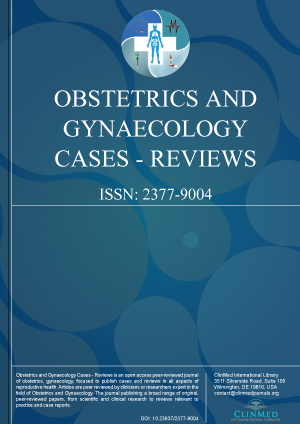Archive
Open Access DOI:10.23937/2377-9004/1410193
Benign, Self-Resolving Subcutaneous Emphysema and Abdominal Crepitus after Open Gynecologic Surgery
Conway Xu, MD, John C Elkas, MD and Chad A Hamilton, MD
Article Type: Case Report | First Published: February 18, 2021
Article Formats
- Full Article
- XML
- EPub Reader
Open Access DOI:10.23937/2377-9004/1410192
Gillian A Corbett, Claire Thompson, Zibi Marchocki and Noreen Gleeson
Article Type: Case Report | First Published: February 15, 2021
Article Formats
- Full Article
- XML
- EPub Reader
Open Access DOI:10.23937/2377-9004/1410191
Clinical Implications and ESHRE/ESGE Classification of Mullerian Anomalies: A Case Series
Uma Gupta, Vartika Tripathi and Priya Sharma
Article Type: Case Series | First Published: February 10, 2021
Article Formats
- Full Article
- XML
- EPub Reader
Open Access DOI:10.23937/2377-9004/1410190
Case Report: Management of an Early Third Trimester Large Adnexal Mass in a Singleton Pregnancy
Lindsay Rucker, MD, Zachary Walker, MD and Brian Casey, MD
Article Type: Case Report | First Published: January 29, 2021
Article Formats
- Full Article
- XML
- EPub Reader
Open Access DOI:10.23937/2377-9004/1410189
Case Report of Pregnancy with Huge Fibroid
Hemali Bharat Karia, MBBS, DGO, Deepa Maniar, MBBS, MD and Ketan Gosai, MBBS, MD
Article Type: Case Report | First Published: January 21, 2021
 Their presence has been linked to spontaneous abortion, intrauterine growth restriction (IUGR), anemia, multiple blood transfusions, infection, pain, degeneration, malposition of foetus, premature labour, uterine inertia, placental abruption, postpartum hemorrhage, retention of the placenta, increased rates of cesarean section, hysterotomy, obstetric hysterectomy...
Their presence has been linked to spontaneous abortion, intrauterine growth restriction (IUGR), anemia, multiple blood transfusions, infection, pain, degeneration, malposition of foetus, premature labour, uterine inertia, placental abruption, postpartum hemorrhage, retention of the placenta, increased rates of cesarean section, hysterotomy, obstetric hysterectomy...
Article Formats
- Full Article
- XML
- EPub Reader

Volume 8
Issue 1
Issue 1
